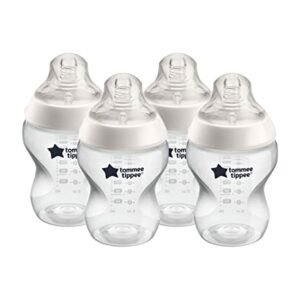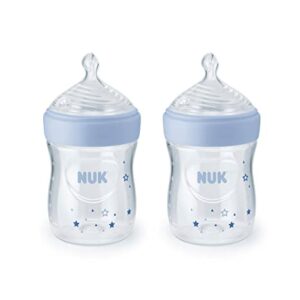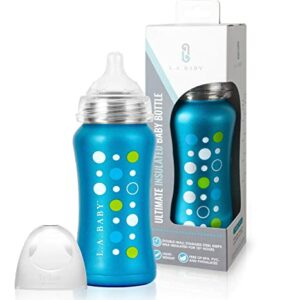Overview
For many new parents, preparing for your baby’s arrival can both be exciting and overwhelming. You might have a lot of questions about all the baby products you’ll need.
You’ll have to make decisions on whether you’ll breastfeed or bottle-feed your baby. You’ll also have to decide which breast pumps to get from insurance, what cribs and mattresses you’ll buy for the nursery, etc.
Whether you’ve decided on breast milk or formula for your little one, you might find yourself asking, “How many baby bottles do I need?”
Continue reading to learn more about the number of baby bottles you should prepare and other relevant information about bottle-feeding.
How Many Baby Bottles Do You Need A Day?
There’s really no specific and absolute rule about the number of bottles you should buy for your baby.
Often, this number would depend on many factors, including your baby’s age and appetite, whether you’re breastfeeding or not, or if you need to prepare extra ones for daycare.
Here’s a handy guide to the estimated number you’ll need to prepare for your little one:
Two To Four Bottles
If you’re breastfeeding and at home most of the time, you’ll likely need just two to four bottles.
You probably won’t need these bottles unless you’re taking your baby out or need to leave your little one for a couple of hours.
Having some bottles on hand can also let your partner take part in feeding your baby.
Three To Six Bottles
If you plan on bottle-feeding your baby, you’ll need around three to four bottles that you have to clean multiple times a day.
You can also opt to buy up to six bottles so you can minimize your cleaning time because you’ll still have some extra bottles to use.
Six Or More Bottles
If you’re a working mom who regularly needs to go out for several hours, it might be a good idea to have more bottles.
It’s ideal to have enough bottles to cover the entire period your child is in daycare or left with a babysitter at home without needing to reuse the bottles or containers.
Depending on how often your baby drinks milk, you might need to prepare one bottle for every two hours that you’ll be away.
You probably need to prepare milk in at least five different bottles, depending on what your baby’s daycare provider requires.
As your child grows older, the number of bottles needed for feeding increases at first. But this gradually decreases as they learn to use a cup or glass for drinking their milk.
Factors To Consider In Buying Baby Bottles
Did you know that there are many kinds of baby bottles you can buy? In choosing the bottles, you have to think about what your baby needs.
The following are some of the factors you should consider in choosing baby bottles:
Types
There are several types of bottles with different designs to match what your baby needs. Others were created to promote better latching or easier feeding.
But you shouldn’t feel bad if your baby doesn’t like the bottle or fails to latch on quickly. Note that babies might respond differently to various baby products.
Standard Or Classic
These baby bottles are thin and have narrow nipples. They might be ideal for preemies because the smaller nipples can better fit the baby’s mouth.
Wide Neck
These bottles may provide better latching because the wider nipples mimic a mom’s breast.
Angled-Neck Or Ergonomic
These bottles have a curved or angled design often touted to be an ergonomic shape, so your baby may better hold them with less effort. But some parents might find the unique design more difficult to keep clean.
Bottle Size
Do I need 4 oz baby bottles?
The following are some of the different bottle sizes available:
- 4-ounce bottles
- 5-ounce bottles
- 8-ounce bottles
- 9-ounce bottles
Younger, smaller babies need less milk per feeding time, while older babies need more. So, you might like to choose the bottle size depending on how much milk the baby needs.
But many parents prefer getting the bigger sizes even if they’ll only be half-filled with milk during the first few months. After all, babies grow quickly within the first year. Soon, a 4-ounce bottle wouldn’t be enough, and you’ll need to buy new bottles if you only got these smaller ones.
Others opt to buy one or two smaller bottles for newborn babies, while the rest are larger bottles that you can continue using as your child grows.
Material
For many decades, only plastic bottles were available for babies. But parents nowadays have more choices:
Plastic
Although they’ve been used for decades, not all plastic bottles are safe for babies.
Make sure that if you’re choosing this kind of bottle, check the label if it’s BPA-free. BPA (bisphenol-A) is a chemical used in manufacturing plastic products, but other much safer alternatives are now available.
Despite having other alternatives, plastic baby bottles remain the most popularly used because of their lower prices and ready availability.
Glass
They’re heavier than plastic bottles and could shatter. Still, some parents prefer glass bottles because they’re safe from BPA and other harmful chemicals used in plastic products. They may also last longer than plastics.
But glass bottles are also more expensive and might not be as easy to find. If you plan on buying some, it’s a good idea to pick silicone sleeves to make them safer for your baby.
Stainless Steel
These bottles are lightweight, unbreakable, and BPA-free. They could be the best choice for your baby. But stainless steel bottles aren’t easy to find and are also expensive.
Because many parents believe that it’s more hygienic to replace baby bottles after several months of use, they might prefer other cheaper options.
Silicone
Just like the stainless steel bottles, silicone ones are also BPA-free, unbreakable, and lightweight. They may also be safer options compared to plastic bottles.
But they’re also expensive and harder to find than plastic ones.
Special Features
In choosing the bottles, you might also consider these special features:
Venting Systems
Some babies are more prone to colic, gassiness, and spit-up.
You might consider getting baby bottles with special venting systems that prevent your baby from ingesting air bubbles.
Aside from the ones with venting systems, you can also find anti-colic bottles with specially designed nipples.
With Disposable Inserts
Some bottles are designed for use with disposable drop-in liners or inserts that you can fill with baby formula or breastmilk.
These liners are intended for single use only, but they’re handy when you’re on the go and can’t clean the bottles immediately.
Our Top Bottle Picks
Philips Avent Natural Glass Bottles




Dr. Brown’s Natural Flow Original Baby Bottle



MAM Anti-Colic Bottles




Tommee Tippee Closer to Nature Baby Bottles




Playtex BabyNurser Bottles with Drop-Ins Liners



Comotomo Baby Bottles (Best Anti-Colic Bottle)




Nuk Simply Natural Bottles



Medela Breast Milk Bottles




L.A. Baby Ultimate Stainless Steel Bottles

 Philips AVENT Natural Baby Bottles (Best for Preemies)
Philips AVENT Natural Baby Bottles (Best for Preemies)



Haakaa Silicone Bottles

Factors To Consider In Choosing Baby Bottle Nipples
Aside from deciding how many and what kinds of bottles you’ll need to buy, you’ll also have to choose different baby bottle nipples.
These are the factors that you should consider in picking the right one to match your baby bottle and meet your baby’s needs:
Nipple Styles
Standard Bulb Type
These standard nipples are narrow and bell-shaped. They’re designed for narrow or classic bottles.
Because they’re narrow, these nipples might also have a slower milk flow than wider ones.
Note that these nipples might make your baby more prone to colic problems, spit-up, and gassiness.
Naturally Shaped Nipples For Wide-Neck Bottles
These products could promote better latching and feeding because they’re designed to mimic the natural shape of a mom’s nipples and breasts.
They’re also wider than standard nipples and can’t fit classic bottles but work well with wide-neck bottles.
Because of their natural design, these nipples are preferred if you’re also breastfeeding. Using them might help your baby avoid nipple confusion, something that could happen when switching between breastfeeding and bottle-feeding.
Orthodontic
These nipples don’t have a dome shape at the tip like other nipple designs. Instead, half of the tip is flat and slopes at an angle from the half-dome portion.
Your pediatrician might recommend this type of nipple when your baby starts teething. It stretches when your baby starts feeding.
Note that because of its asymmetrical tip, this nipple needs to be positioned properly to prevent leakage.
Expandable Nipple
These special nipples are designed to elongate as your baby feeds, but only if your baby sucks hard to draw the nipple farther in and opens his mouth wider.
While these nipples may promote better feeding, you should avoid using them if you’re breastfeeding. Your baby might develop lazy latch-on habits and refuse to feed on your breast.
Nipple Sizes & Flow Rate
It’s important to ensure that the nipples you buy will fit the baby bottles you already have.
It might be easier to simply pick a nipple from the same brand as the baby bottle when looking for additional or replacement parts.
Make sure to double-check the size so that you know you’re buying the nipple that fits the bottle, whether it’s narrow or wide-neck.
Aside from the size, you should also check for the flow rate. Different brands might use different codes, but most will indicate the flow rate and the recommended age.
The number indicates the hole on the nipple (for example, size one has one hole while size two has two holes).
It may be safer to start with the lower numbers, then gradually increase the flow rate or size as your baby grows.
Note that you’ll likely be replacing nipples more than you’ll be getting new bottles.
Many babies tend to bite on the nipples and create bigger holes, especially when they’re teething. Make sure to replace these damaged nipples to prevent leaks and accidents.
Newborn Nipples
Best for newborn babies, these nipples are often in size one.
But you can also get the slow flow size zero for preemies or newborn babies who might have difficulty handling the faster size one.
Slow Flow Nipples
Typically, the nipples for younger babies are slow flow and have two or three holes (sizes two and three). These may be best suited for babies who are three to six months old.
Some brands also use “medium flow.” If you’re unsure, check the holes at the tip of the nipples.
Fast Flow Nipples
As your baby grows, there’ll be an increased demand for milk. You might notice that your baby might be feeling frustrated during feeding time because the milk flow is now too slow for him.
You can start using size three or four when your baby is around five or six months old.
Some brands offer size five nipples or simply label them as “fast flow.”
These fast flow nipples are also useful if your pediatrician recommends adding more formula to thicken your baby’s milk.
Most pediatricians will also recommend introducing your baby to sippy cups and gradually learning to drink from a regular cup after their first birthday.
Materials
Latex
Nipples made from latex may be softer, more flexible, and cheaper than silicone, but they also tend to rip easily. These nipples aren’t durable, and some babies might also be allergic to the latex material.
Still, many parents still prefer the softer latex. That’s fine, but make sure you’re buying BPA-free nipples.
You might consider also these disadvantages when choosing latex nipples:
- They have amber or dark yellow color, which some parents might find unpleasant.
- Latex tends to retain odors and could be displeasing, especially if the nipples previously had spoiled milk.
- The material might deteriorate faster with exposure to direct sunlight or heat.
- The nipple could develop a sticky coating as the latex begins to break down within around two months of use.
Silicone
Nipples made from silicone are typically harder than latex and could make breastfed babies more prone to nipple confusion.
Silicone nipples are also more expensive than latex. But because they’re more durable, many parents still prefer to buy them, especially for formula-fed babies.
Special Features
Anti-Colic Nipples
Aside from regular nipples, you might also consider anti-colic nipples.
Designs vary across brands, but these nipples typically have special valves that flex to your baby’s feeding rhythm. This mechanism can make feeding more comfortable for your baby and also reduce air bubbles.
Disposable Nipples
Sometimes, it might be difficult to clean and sterilize your baby bottles when you’re on the go or taking a long trip with your baby.
Disposable nipples might not have the best design, but these typically inexpensive items can help you during these times.
You can just discard them after each use.
While these disposable nipples can be useful during trips and emergencies, some parents may still want to avoid them for their negative environmental impact.
Other Must-Haves For Baby Bottle-Feeding
The following must-haves can help make bottle-feeding more efficient and hassle-free:
- Tote bag
- Bottle warmer
- Cleaning materials (bottle brush, etc.)
- Sterilizer
- Bottle drying rack
- Dishwasher basket
- Silicone sleeves for glass bottles
Safety Tips In Bottle-Feeding & Buying Baby Bottles
Take note of these safety considerations for bottle-fed babies:
- Always check for product recalls before buying any baby products, particularly bottles and nipples that directly touch your baby’s mouth and skin.
- Make sure to choose BPA-free bottles if you’re planning to buy plastic ones.
- Never heat plastic bottles in the microwave or put them in the dishwasher. Doing so could release harmful chemicals that your baby might ingest.
- Regularly check bottles and nipples for cracks and damages that might pose a choking hazard to your baby. These cracks can also harbor bacteria and cause leakage.
- Make sure you’re only using clean water, bottles, and nipples when preparing your baby’s milk.
- Follow your pediatrician’s recommendations and make sure to consult them if your baby is having feeding problems.
- After each feeding session, don’t forget to burp your little one.
Bottle-Feeding FAQS
How Often Should I Feed My Baby?
In general, most newborn babies feed every two to three hours. The frequency changes to around three to four hours as they grow older, and their tummies can hold more milk.
If your baby has weight problems, your pediatrician might recommend more frequent feedings until the desired weight is achieved.
Note that there’s no specific time range for feeding. But you can also feed on demand.
You can feed your baby when you notice tell-tale signs of hunger, such as nuzzling against your breasts, crying, or moving their tongues and lips as if they’re suckling.
How Many 8 Oz Bottles Does A Baby Need?
Babies may have different appetites and milk needs, but these are the typical amount they’ll need, depending on age:
- Newborn babies: 1.5 to 3 oz every two to three hours
- Two to four months: 4 to 5 oz every three to four hours
- Four to six months: 4 to 6 oz every three to six hours
- Six months and above: 6 to 8 oz every four to six hours
How Long Should A Bottle-Feeding Take?
Again, this largely depends on your baby. But bottle-feeding typically takes around 15 to 20 minutes.
Other moms opt to stop every ounce to burp their babies. It could increase the average feeding time to around 45 minutes to one hour but can help avoid spit-up.
How Long Does A Baby Bottle Last?
As a general rule, an unused bottle of milk can last for one hour to 90 minutes at room temperature. But you should discard leftovers from a bottle about an hour after your baby starts feeding on it.
It might be tempting to put the bottle in the fridge to reuse the formula, but there’s a risk of bacterial contamination.
If in doubt over how long the bottle has been in your fridge, throw it out.
It’s better to just make a fresh batch with a sanitized bottle than try to save a couple of dollars, only for your baby to get sick from the spoiled or contaminated milk.
How Often Should You Buy New Bottles For Baby?
It may be ideal to replace your baby’s bottles every four to six months.
When Should I Switch From Slow Flow To Fast Flow Nipples?
It’s a good idea to follow the manufacturer’s recommendation on the package. If your baby appears frustrated because the milk flow might be too slow, you can switch to a fast flow nipple ahead of the recommended schedule.
But make sure to check whether your baby can handle the faster flow if you had just switched from a slow flow nipple.
Other Breastfeeding Essentials
- Breast Pumps From Aeroflow Healthcare
- Natural Curve Nursing Pillow
- BabyCubby Multi-Use Nursing Cover
- Boob-ease Organic Soothing Therapy Pillows












